
What is a torn disc?
A torn disc is a phrase that is often used to describe an annular tear which occurs inside the intervertebral disc. Typically, an annular tear occurs with age. Our vertebral discs can dehydrate with age, weaken and tear internally. A torn disc can aggravate the nerve endings that occupy the denser fibers of the outer edge of the annulus. With time, the acute pain of a torn disc can become a nagging chronic pain.
Sometimes the tears can enlarge and become fissures that lead to herniations which allow fluid and tissue to leak from the soft, jelly-like center of the nucleus pulposus.
Your vertebral discs serve as shock absorbers, cushioning the spinal column. Not surprisingly, losing the structural support of a disc will cause pain which can intensify with movement. Occasionally, the annular tear will stimulate the transversing nerve and cause a form of pain called radiculopathy which is felt in your arms and legs.
How is a torn disc evaluated?
An MRI is often the best choice for identifying an annular tear. It allows your spinal doctor to assess whether an annular tear is concentric, transverse or radial in its orientation, plus it helps pinpoint the layers in the nucleus pulposus.
A CT scan will identify nerve roots or spinal cord compression, but it may not identify edema in the disc and the tell-tale signs of fissures or tears that have not yet caused herniations which is why an MRI is most often used.
How is a torn disc treated?
Doctor Melamed has a wide range of non-invasive, non-opioid pain relief strategies that can bring welcome relief to the pain caused by torn discs.
Torn discs and annular fissures are indications that degenerative disc disease may be starting. There are several integrative medical techniques that reduce acute and chronic pain and slow disc degeneration.
Pain is real, but Dr. Melamed has developed a way to control it by looking at pain through a holistic lens to help the patient optimize simple behaviors using Integrative Medicine Techniques, Lifestyle Optimization, and the adoption of an anti-inflammatory diet program.
Most patients respond well to these holistic solutions, but some patients don’t. If surgery is your best choice, Dr. Melamed will review all your surgical options and his Opiate-Free Surgery and Pain Management System which has helped hundreds of patients recover from back pain.
Find out what’s causing your back pain.
Click on the “Make An Appointment” button at the top of this page, or call Dr. Melamed’s office for more information. Call us at 310-928-2769.
References:
1. Low Back Pain and Lumbar Spine Osteoarthritis: How Are They Related; A. Goode, T. Carey; Curr Rheumatol Rep. 2013 Feb; 15(2): 305.doi: [10.1007/s11926-012-0305-z]
2. Arthritis and Arthroplasty, Edited by F. Shen & C. Shaffrey, Pg. 24, Elsevier Health Sciences



